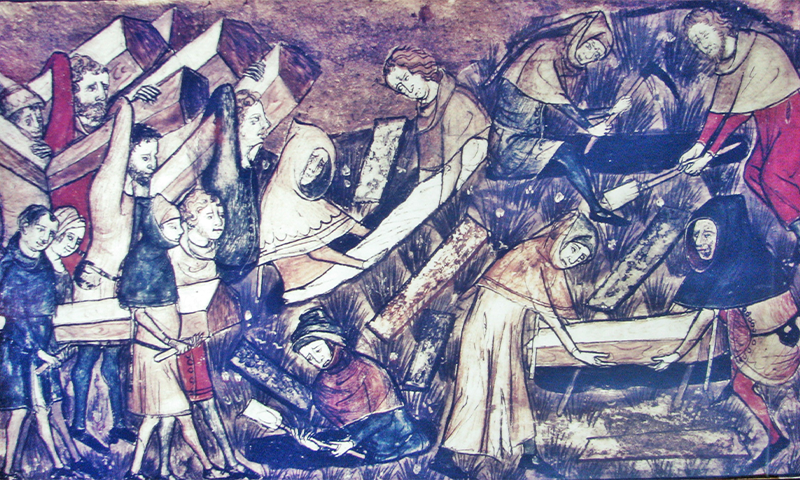Listen to the article
Centuries before questionable COVID-19 information began circulating on social media, an early spread of misinformation about infectious disease was already taking root in historical literature. A recently published study has revealed how a medieval poet’s creative account of the Black Death created a myth that has persisted for centuries.
Between 1348 and 1349, Syrian scholar Ibn al-Wardī composed a rhyming tale called “Risālat al-nabaʾʿan al-wabāʾ” (“An Essay on the Report of the Pestilence”), portraying the plague as a traveling trickster that rapidly moved from an unidentified “land of darkness” to China and then to the Mediterranean in just 15 years.
This account was never meant to be taken as historical fact. According to research published in the Journal of Arabic and Islamic Studies, al-Wardī’s work was actually a maqāma—a literary form featuring rhymed prose and often depicting the adventures of a trickster character. However, 15th-century scholars interpreted the account literally, establishing a persistent theory that the Black Death spread quickly across continents via trade routes over roughly a decade.
“All roads to the factually incorrect description of the spread of the plague lead back to this one text,” said Nahyan Fancy, a historian of Islamic medicine from the University of Exeter, in a statement. “It’s like it is in the centre of a spider’s web of the myths about how the Black Death moved across the region.”
The Black Death pandemic was devastating, killing approximately 50 million people in Europe and the Mediterranean between 1346 and 1353. It remains the deadliest pandemic in recorded history, wiping out substantial portions of the population in affected regions.
Recent scientific evidence contradicts the timeline suggested in al-Wardī’s tale. DNA analysis of human remains indicates that the strain of bubonic plague responsible for the Black Death likely emerged in what is now Kyrgyzstan, supporting theories of a Central Asian origin. However, the rapid continental spread described in al-Wardī’s account doesn’t align with biological or historical evidence.
“The notion that a lineage of this bacterium moved over 3,000 miles overland within a few years, and established itself sufficiently to cause the devastating Black Death of the Middle East and Europe makes little historical or biological sense,” write Fancy and his co-author Muhammed Omar, a Ph.D. candidate in Arab and Islamic Studies.
The misinterpretation of al-Wardī’s work highlights a recurring challenge in historical research: distinguishing between literary devices and factual accounts. The confusion was compounded when al-Wardī himself quoted portions of his maqāma in his historical writings, blurring the line between creative expression and documented history.
This case illustrates the enduring power of compelling narratives. Even when contradicted by scientific evidence, an engaging story can shape perceptions for centuries. The misunderstanding of al-Wardī’s literary work as literal history influenced generations of scholars and their understanding of how pandemics spread across medieval trade networks.
Despite the factual inaccuracies, researchers Fancy and Omar note that such creative works offer valuable cultural insights. These literary responses to catastrophic events reveal how people used creative expression to process and cope with the unfolding tragedy of the Black Death, even if the resulting works took artistic liberties with factual details.
The study serves as a reminder that misinformation about disease has deep historical roots predating modern concerns about social media’s role in spreading health misinformation. Even in medieval times, compelling but inaccurate narratives could shape public understanding of disease transmission and epidemiology.
As modern researchers continue to uncover the actual origins and spread patterns of the Black Death through advanced DNA analysis and archaeological evidence, they must carefully distinguish between historical facts and the creative responses that catastrophic events inspired in the societies they affected.
Fact Checker
Verify the accuracy of this article using The Disinformation Commission analysis and real-time sources.




8 Comments
The persistence of medieval medical myths is a fascinating topic. It’s a good reminder that just because something has been around for a long time doesn’t mean it’s accurate or based on solid evidence. Rigorous analysis is key to separating fact from fiction.
Fascinating how medieval myths can persist for centuries, even influencing modern beliefs. It’s a good reminder to be critical of historical accounts and not take them at face value, especially when they have a fantastical or exaggerated nature.
I agree, the tendency to interpret creative literary works as historical fact is quite concerning. Careful analysis is needed to separate myth from reality, especially when it comes to the spread of diseases.
This is a really interesting example of how misinformation can take root and spread, even centuries ago. It’s a good lesson on the importance of verifying sources and not simply accepting historical narratives at face value.
Agreed. It’s a sobering reminder that misinformation and the spread of false narratives is not a uniquely modern phenomenon. We must always be vigilant in our approach to historical accounts and claims.
This study highlights how misinformation can take root and spread, even in the pre-digital era. It’s a sobering lesson on the importance of verifying sources and not blindly accepting historical narratives, no matter how long-standing they may be.
Absolutely. Fact-checking and critical thinking are essential, even when it comes to well-established historical accounts. Myths and legends can often become accepted as truth over time.
The study’s findings are a cautionary tale about the dangers of taking creative literary works as historical fact. It’s a good reminder to approach all sources, even long-established ones, with a critical eye and a willingness to question accepted narratives.